-
Paper Information
- Paper Submission
-
Journal Information
- About This Journal
- Editorial Board
- Current Issue
- Archive
- Author Guidelines
- Contact Us
Archaeology
2015; 4(1): 13-21
doi:10.5923/j.archaeology.20150401.02

MeymanatAbad Tepe: An important Site in Late Fourth Millennium BC in Iranian Central Plateau
R. Yousefi Zoshk1, Kh. Beik Mohammadi2, M. Zeighami3, S. Baghizadeh4, M. Golcheh5, H. Ahmadpour4, J. Miri5, M. Ghaderi Nezhad4, N. Nezari4, N. Beik Mohammadi6, E. Alimadadi4, M. Sadeghi4, M. Hamivand4
1Assistant professor, Islamic Azad University of Varamin-Pishva, Iran
2PHD Student, Prehistoric Archaeology, University of Mohaghegh Ardabili, Iran
3PHD Student, Prehistoric Archaeology, Bu-Ali University of Hamadan, Iran
4M.A. Graduated, Prehistoric Archaeology, Islamic Azad University of Tehran (Central Branch), Iran
5M.A. Student, Prehistoric Archaeology, Islamic Azad University of Abhar, Iran
6M.A. Student, Islamic Archaeology, Bu-Ali University of Hamadan, Iran
Correspondence to: S. Baghizadeh, M.A. Graduated, Prehistoric Archaeology, Islamic Azad University of Tehran (Central Branch), Iran.
| Email: |  |
Copyright © 2015 Scientific & Academic Publishing. All Rights Reserved.
This work is licensed under the Creative Commons Attribution International License (CC BY).
http://creativecommons.org/licenses/by/4.0/

Iranian Central Plateau along with all environmental restrictions and capacities had a key role in Prehistoric time. During the Late Chalcolithic Period and with the increase of Complexity, the ancient societies had been connected with each other and traded the exotic and essential sources. Meymanatabad is located on the southwest of Tehran. It was excavated in the summer of 2012. The main objectives were to explore the stratigraphic sequences of the site and relative and absolute chronology from the lower layers to the end of settlement. In this paper, only the relative chronology results have been pointed and it is hoped that absolute chronology results are independently released in another article, which is currently under consideration. The study shows us Meymanatabad had continuous evidence from Sialk III6 (with the painted black on buff pottery) to Sialk IV (with the presence of Uruk trays and Bevel-rim Bowl) that indicates the interaction between Iran and Mesopotamia.
Keywords: Late chalcolithic period, Meymanatabad, Stratigraphic sequences, Sialk III6-7
Cite this paper: R. Yousefi Zoshk, Kh. Beik Mohammadi, M. Zeighami, S. Baghizadeh, M. Golcheh, H. Ahmadpour, J. Miri, M. Ghaderi Nezhad, N. Nezari, N. Beik Mohammadi, E. Alimadadi, M. Sadeghi, M. Hamivand, MeymanatAbad Tepe: An important Site in Late Fourth Millennium BC in Iranian Central Plateau, Archaeology, Vol. 4 No. 1, 2015, pp. 13-21. doi: 10.5923/j.archaeology.20150401.02.
Article Outline
1. Introduction
- The modality of Transition period from Late Chalcolithic to Bronze Period in Iranian Central Plateau is one of the important and ambiguous problems in this scope. A few sites including this era, untargeted studies in these sites and discontinuity stratigraphy on these sites is due to the lack of completed understanding of final developments in late fourth and early third millennium BC. The surface evidences from Meymanatabad tepe shows the cultural and commercial contacts between adjacent sites such as Tepe Sialk, Arisman, Hissar Tepe, Ozbaki Tepe and Ghabristan. Therefore, the excavation of Maymanatabad tepe could open a new horizon on the study and analysis of settlements.
2. The Location of Meymanatabad Tepe
- Meymanatabad Tepe (N 3928141.46 and S 515322.47, AMSL: 1053.96 m) is located in southwest of Tehran, in Robat Karim district and in 500 meters of south of MeymanatAbad village (Fig 1). Shad Chai River, the tributary stream of Karaj river, is 300 meters in the east of this Tepe (Fig 2.). This site consists of two low mounds; Northern Mound (Fig 3) and Southern Mound (Fig 4). MeymanatAbad Tepe is extended to 612×423 meters (Area: 5.1 ha) and almost its height is 4.73 meters from plain levels. Fazeli Nashli was the first person who explored this site in 1998 A.D. (Fazeli Nashli 2001) and then three years later, Baqeri surveyed it (Rahimi 2011). The southern Mound has three occupation phases of Sialk III6-7 with two architecture levels. Furthermore, the northern mound has continuous sequences of Sialk III7 and IV1 (Uruk findings) on the top (Fig 5).
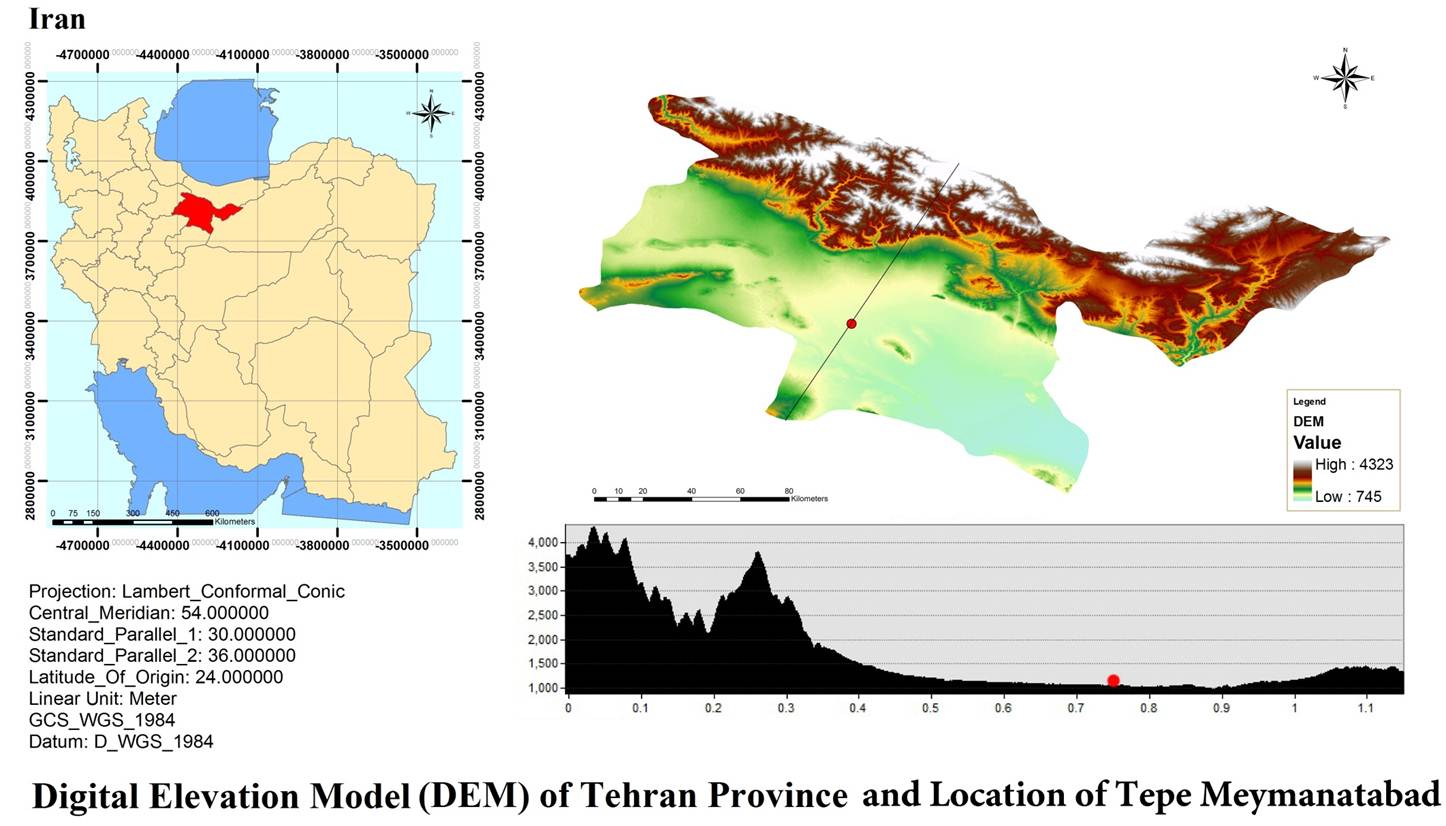 | Figure 1. The geographical and DEM map of Tepe Meymanatabad |
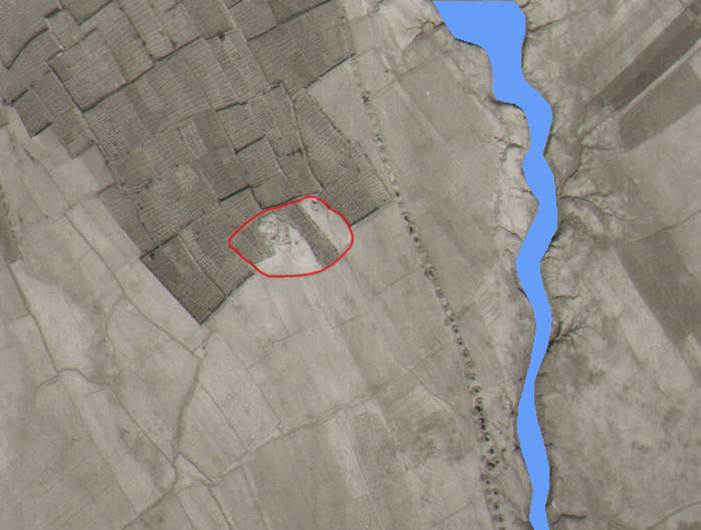 | Figure 2. The geographical Location of Shad Chai River |
 | Figure 3. The Northern Mound of Tepe Meymanatabad |
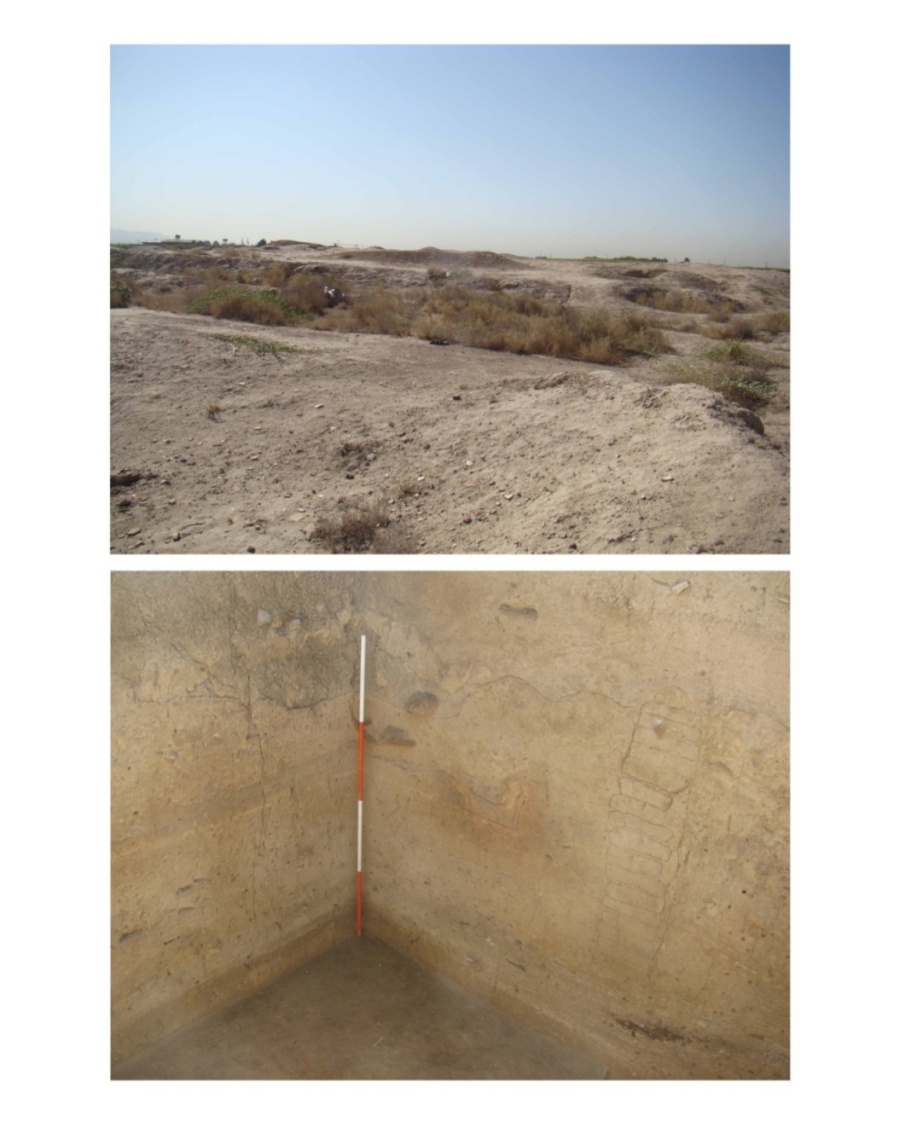 | Figure 4. The Southern Mound of Tepe Meymanatabad |
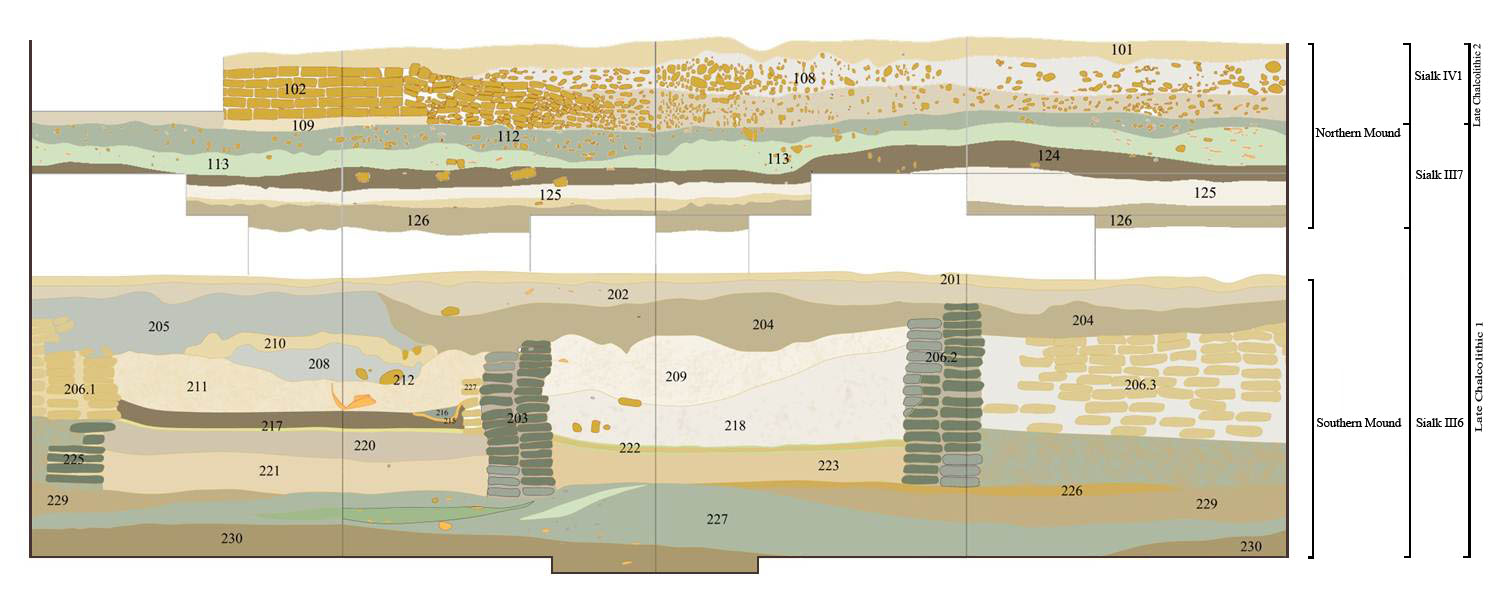 | Figure 5. The stratigraphy of Tepe MeymanatAbad |
3. Method of Excavation
- Our project has two field stages. First, MeymanatAbad was surveyed using the stratified systematic sampling and then these materials were analyzed (Rahimi 2011). Afterwards, on the basis of frequencies of pottery’s distributions (Fig 6), the excavation was performed in September 2011 (Yousefi Zoshk 2011). We dug out two trenches in Northern and Southern mound. The database was built with 3D analysis system, which means all the material cultures with no exceptions were recorded and registered and mapped with total station and were entered into GIS database (Fig 7). After field stages, we registered all findings in Microsoft Access Databases and analyzed them.
 | Figure 6. The Distribution of Pottery at Tepe Meymanatabd |
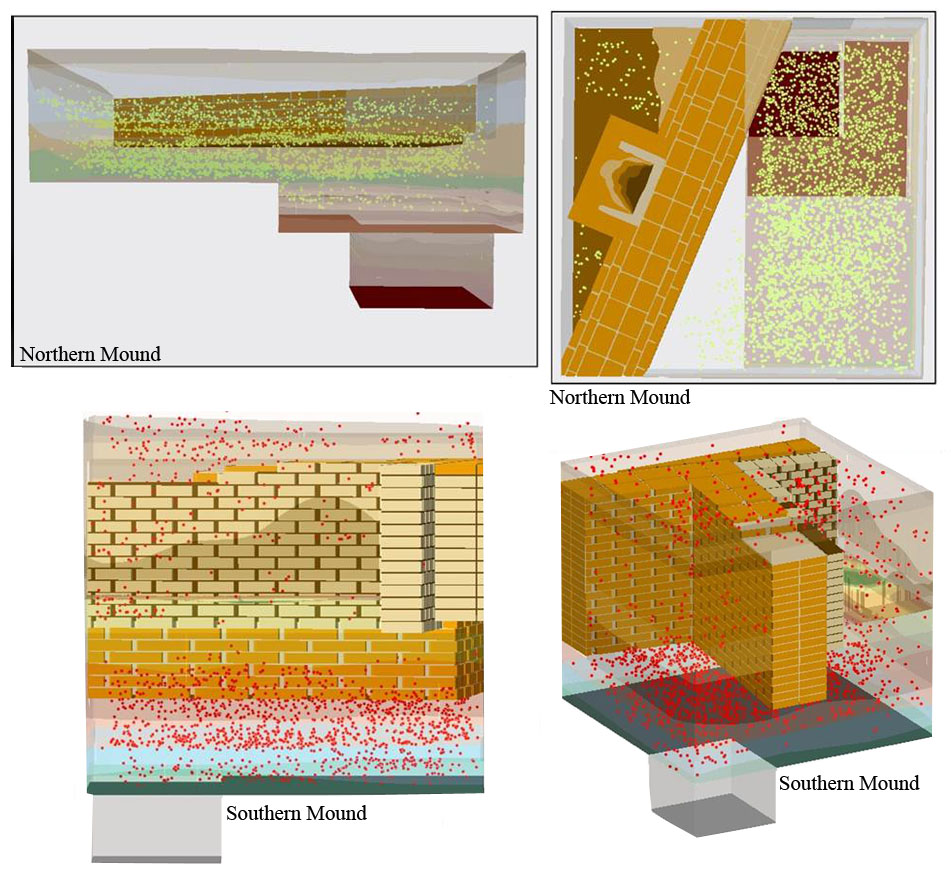 | Figure 7. The 3D analysis Pattern of Findings |
4. Pottery
- The trench of southern has an approximate length and width of 3 meters was excavated to 3.5 meters under the ground. This has 4 stages from the bottom to up and dated back to late chalcolithic period (Sialk III6). The Late Chalcolithic period is characterized by increased interaction between Iranian Central Plateau, central Zagros, and Mesopotamia as attested by the presence of painted buff ware, string cut bases, and bevel-rim bowls. The Southern mound has a continuity of pottery tradition in Sialk III6. The pottery was buff, painted and fine and the forms included cups, deep bowl with plain bases, etc. Common forms included vertical and inverted-rim hemispherical bowls of shallow to medium depth, some with a pedestal base painted with rows of animal decoration such as leopards, goats with S-shaped horns, and cups and open bowls with concave and oblique walls, incurving and flared rims, and flat base. Most motifs consist of geometric designs but stylized animals such as goats, leopards, cattle, and birds were found in abundance. On the basis of potteries, Six general forms were distinguished (Fig 8 & 9); 1) Coarse-Red Chaff Tempered Ware, 2) Meander Washed Buff Wares, 3) Plain Slipped Buff Wares 4) Early Black on Buff (B-on-Bf) wares, 5) Transitional B-on-Bf wares (A: Early Transitional and b: Late Transitional), 6) Standard B-on-Bf wares. These styles and motifs are similar and parallel to Arisman B (Boroffka & Parzinger 2011), Sialk III6-7 (Ghirshman 1938), Ghabristan IV, layer of 6-4 (Majidzadeh 1976), and Godin VI:3 (Rothman & Badler 2011).
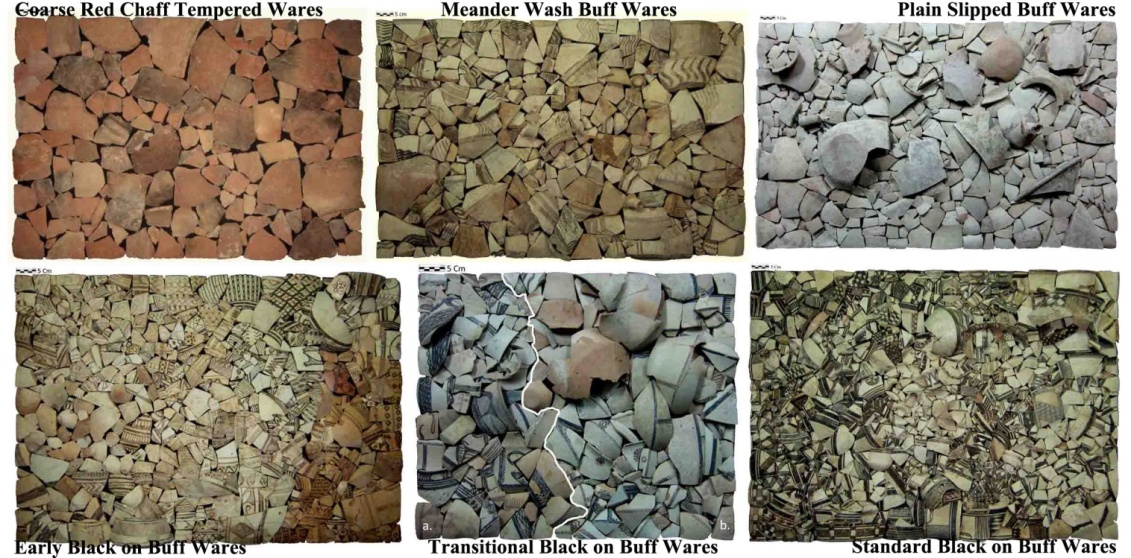 | Figure 8. The Pottery of Southern Mound (Sialk III6-7) |
 | Figure 9. The Pottery of Southern Mound (Sialk III6-7) |
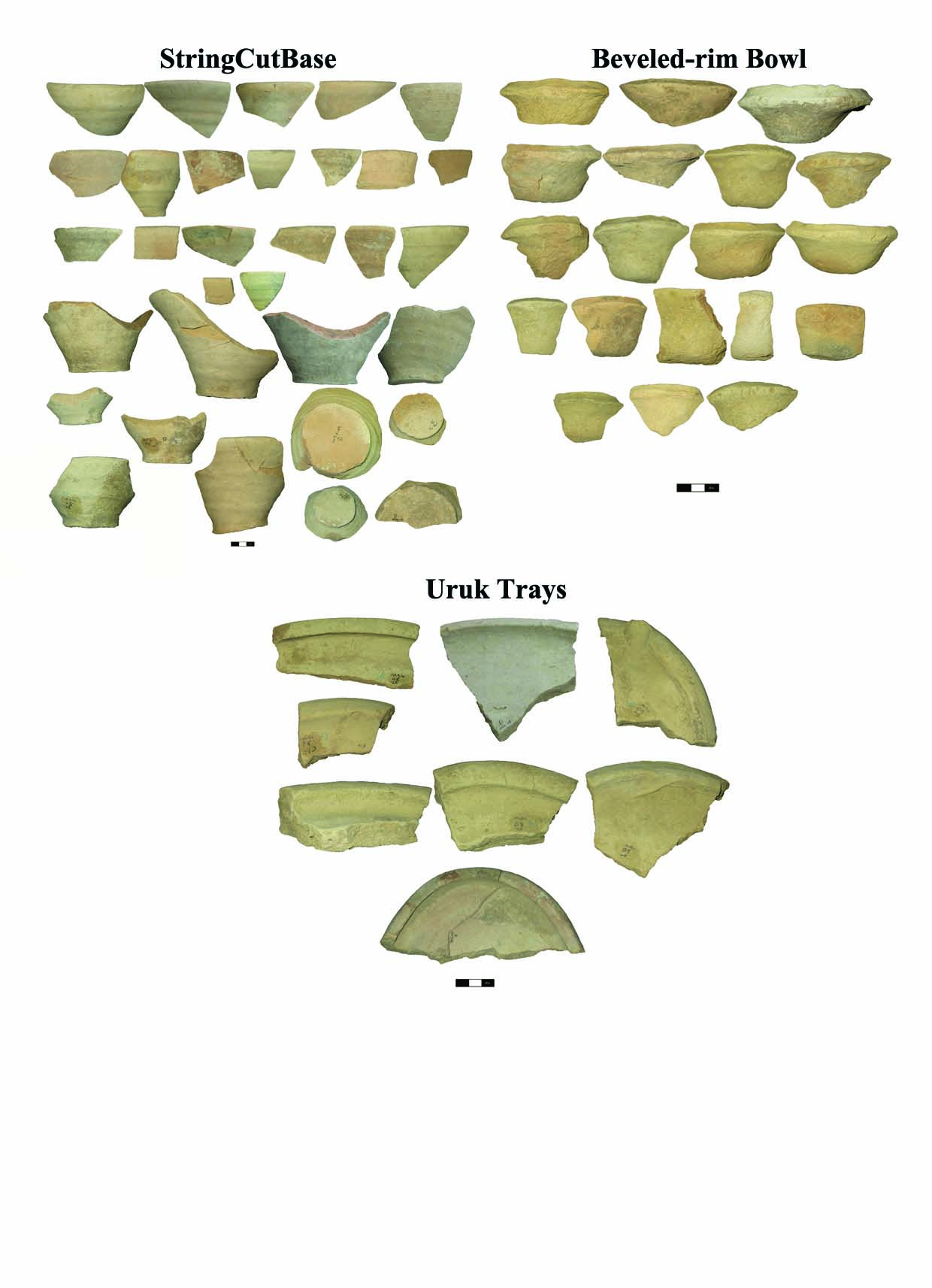 | Figure 10. The Pottery of Northen Mound (Sialk IV1: Uruk Type) |
 | Figure 11. The Pottery of Northen Mound (Sialk IV1: Uruk Type) |
5. Other Findings
- On the Survey, we found a bronze dagger, a few slags and a piece of shell. In excavation stage, there is a great architecture of Uruk period. The Uruk period at MeymanatAbad is a single level. It appeared at the top of Northern mound and below the soil Surface. During the excavation, we could unearth a 5.37 cm long wall plus a plastered platform attached to it on which a fireplace was constructed. For reconstructing the wall, we carried on geophysics surveys and their result shows the traces of long wall (fig 12).
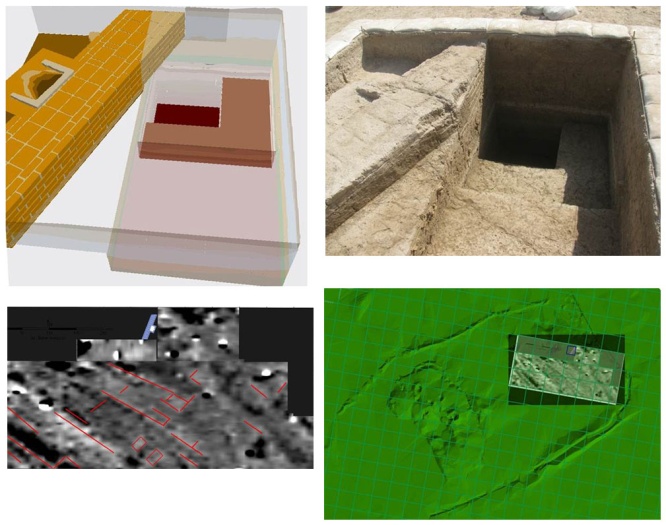 | Figure 12. A wall of Northern Mound |
6. Conclusions
- The material evidences based on cultural developments along with regional origins as well as foreign evidences, indicated economical sources that are the reason of communication between far-off regions. In MeymanatAbad site, these are clear evidences of continuity of pottery’s style along with inner changes that indicated gradual developments from domestic pottery-making toward specialized and mass producing with uniform standards.
ACKNOWLEDGEMENTS
- The excavations at Tepe Meymanatabad were made possible by the financial support of Islamic Azad University of Varamin-Pishva Branch (with particular thanks to Dr. Maryam Eidi). We also would like to acknowledge the support of a Dr. Rabei Mandajin, Head of the University. We would also like to extend our thanks to the anonymous reviewer.
 Abstract
Abstract Reference
Reference Full-Text PDF
Full-Text PDF Full-text HTML
Full-text HTML